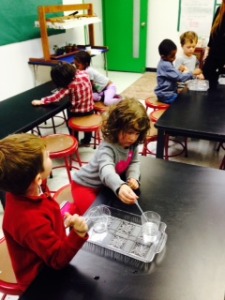Our elementary school students have so many amazing specials. Here is the September update from our special teachers:
WOODSHOP WITH ROTEM!
The Bumblebees, Beetles and Dragonflies:
The pre-k learned a lot this month in the woodshop. We learned about woodshop safety—how to protect our bodies and our friends. We went over the safety gear, goggles and headphones and how to handle tools and materials in the shop. We also learned a song that will help us concentrate in the woodshop. We learned how to hammer using hammers and nails. We practiced holding and aiming nails using foam practice boards. Our boards had pictures with missing parts and numbers on them—we found the numbers and completed the pictures using nails. This week we learned how to use the coping saw. Using our foam practice boards we first marked our cut and, using the vises, practiced sawing. I’m excited to see what the Bumblebees, Beetles and Dragonflies will make with all of their new woodshop skills…
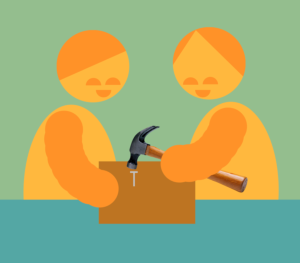
The Katydids:
The Kindergartners started working on a treasure chest project. We went over all of the important woodshop safety rules. We talked about the different ways we can help protect our bodies and how to work together in the woodshop—from goggles and headphones to how to walk with tools and the importance of being concentrated in the shop. We practiced planning and marking our material and following our plan. We sanded our wood, lined up out material, made marks for nails and prepared our pieces. We used sandpaper, sanding blocks, hammers, nails, saws, vices and clamps. We will be making treasure chests for keeping all of our interesting objects, materials and images.
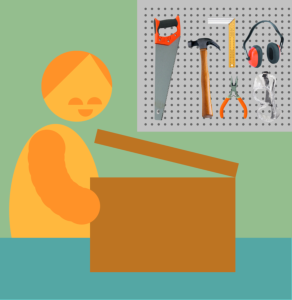
The Sharks:
The first graders are working on building the subway of the future. We started by talking about how the subway has changed since it was first built and then we tried to imagine what might happen in the future. What will the subway look like in 100 year? Where will it go? How? With these questions in mind we each designed a single subway car from the future we imagined. Using our designs started assembling the different parts of our cars. We are now working on building a base for each car on which we will add everything our subway will need. We practiced marking our material and making a plan, using the vises, hammers, saws and nails. We went over woodshop safety—hammer walk, goggles, headphones, concentration and respecting our friends space as they work.
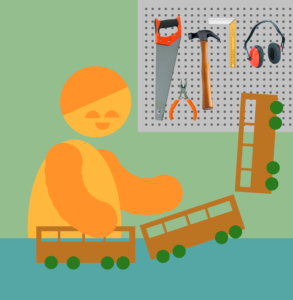
The Centipedes:
The second grade reviewed woodshop rules and safety that they had learned last year. We went over how to protect our bodies and friends, the reasons for wearing safety gear, how to handle tools and why it’s important to stay focused in the woodshop. The Centipedes discussed how woodshop relates to construction and how we can learn about building and making things using different materials and tools. We talked about construction and are now working on building a city! Each Centipede is building one building. We made plans and designs and decided what kind of building we each wanted to build—houses, dance halls, train stations and more. I’m excited to see what kind of a city we get when we put all of our buildings together…
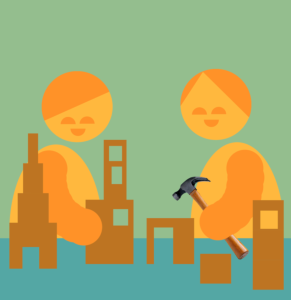
SCIENCE WITH NICOLE!
Beetles:
It’s been such a pleasure getting to know the Beetles. In early September, we began by getting acquainted with the new layout and guidelines of the art studio and getting to know the materials. The Beetles were introduced to their personal sketchbooks, that they will be working in this year and got right to work on decorating and personalizing them. Their sketchbooks are an outlet for free drawing or writing at the end of class when there is extra time. Since then the Beetles have been learning about different types of line. We started by discussing the difference between paintings and sculptures, and looked at work by Alexander Calder and the Statue of Liberty. The Beetles learned that by folding the ends of their paper lines into “feet,” and gluing the bottom of their feet, their lines could pop off the paper and become a sculpture. The Beetles’ line sculptures have become even wackier with the addition of zig zag lines, curls, loops and shapes last week. At the end of class, we spent a few minutes reading from the book When A Line Bends, A shape Begins by Rhonda Gowler Greene.
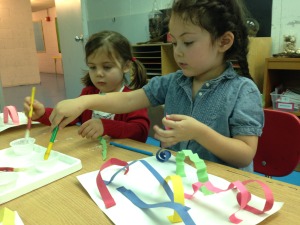
Dragonflies:
The Dragonflies are off to a great start in the art studio. We took the first class to get acquainted with the new layout, materials and guidelines of the studio. The Dragonflies decorated and personalized their new personal sketchbooks that they will be working in this year. Their sketchbooks are an outlet for free drawing or writing at the end of class when there is extra time. Since then, the Dragonflies have been learning about different types of line. We started by discussing the difference between paintings and sculptures, and looked at work by Alexander Calder and the Statue of Liberty. The Dragonflies learned that by folding the ends of their paper lines into “feet,” and gluing the bottom of their feet, their lines could pop off the paper and become a sculpture. The Dragonflies’ line sculptures have become even wackier with the addition of zig zag lines, curls, loops and shapes last week.
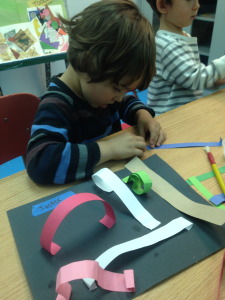
Bumblebees:
The Bumblebees have had an impressive start in the art studio. In early September, we began by getting acquainted with the new layout and guidelines of the studio and learning about the materials we would be working with. The Bumblebees were introduced to their personal sketchbooks that they will be working in this year and got right to work on decorating and personalizing them. Their sketchbooks are an outlet for free drawing or writing at the end of class when there is extra time. Since then the Bumblebees have been learning about different types of line. We started by discussing the difference between paintings and sculptures, and looked at work by Alexander Calder and the Statue of Liberty. The Bumblebees learned that by folding the ends of their paper lines into “feet,” and gluing the bottom of their feet, their lines could pop off the paper and become a sculpture. The Bumblebees’ line sculptures have become even wackier with the addition of zig zag lines, curls, loops and shapes last week. At the end of class, we spent a few minutes reading from the book When A Line Bends, A shape Beginsby Rhonda Gowler Greene.
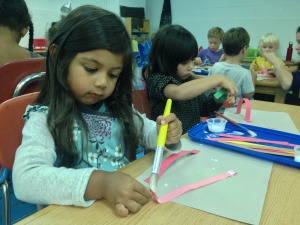
Katydids:
The Kindergarteners are off to a fantastic start in the art studio. We took the first class to get acquainted with the new layout, materials and guidelines of the studio. The Katydids decorated and personalized their personal sketchbooks that they will be working in this year. Their sketchbooks are an outlet for free drawing or writing at the end of class when there is extra time. The next class we jumped into collage, exploring paper with varying patterns, textures and shapes. Collage provides tactile opportunities to arrange and modify ideas and see how their physical actions have visual consequences. The Katydids collected various paper of their choosing and created either a design or a collage of a special activity that they do with their family. Currently, the Katydids are working on collage self-portraits made from cardboard and other recycled materials from the resource room. Beginning with pre-cut cardboard shapes, the Katydids selected pieces to represent their body and have been busy adding details and facial features to their cardboard bodies with fabric, beads, buttons, feathers and yarn.
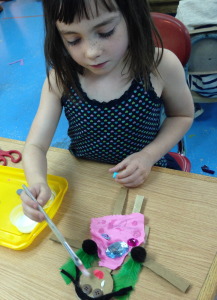
Centipedes:
The First Graders are off to a great start in the art studio. In early September, we began by getting acquainted with the new layout and guidelines of the studio and getting to know the materials. The Centipedes were introduced to their personal sketchbooks that they will be working in this year and started off decorating and personalizing them. Their sketchbooks are an outlet for free drawing or writing at the end of class when there is extra time. Since then, they have been working on a watercolor painting in which they represented their favorite thing about the Co-op School. We began by discussing our school community and what makes it special. The Centipedes took time to write down their ideas, before moving on to a drawing. The following class we did a watercolor exploration investigating how to mix and best spread watercolors on paper. The Centipedes then added watercolors to their drawing. This watercolor painting “quilt” will be displayed in the basement hallway when finished.
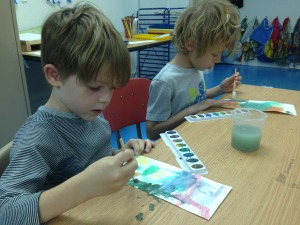
Sharks:
The Second Graders are off to a fantastic start in the art studio. We took the first class to get acquainted with the new layout, materials and guidelines of the studio. The Sharks decorated and personalized their new personal sketchbooks that they will be working in this year. Their sketchbooks are an outlet for free drawing or writing at the end of class when there is extra time. The next class we jumped right into transportation collages. We discussed different types of transportation as well as our favorite ways to travel in the city. Since then, the Sharks have been working intently on their transportation collages, selecting, cutting, arranging and pasting paper of various textures, patterns and shapes to best represent their ideas. Some are based on real life events, some fantastical. I am really proud of how hard they are working and can’t wait for you to see them.
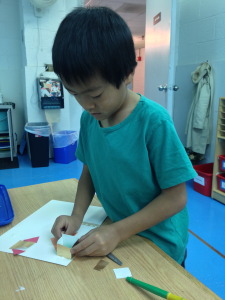
Dragonfly:
Prek Dragonflies did some great seed saving! We started off investigating an ear of corn Red Seneca Corn, an ornamental corn that originated with the Seneca Nation of Indians, and grown in the Irving Co-op Garden from organic seeds donated by a Co-op parent. We noticed that the husk of this ear of corn was dark red rather than green and talked about how each kernel of corn could become a new huge corn plant.
Vocabulary – husk, silk, ear, cob, kernel, stalk
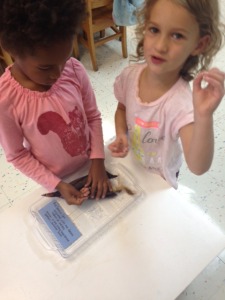
We then moved on to cucumbers, one that we picked from the dragonfly planter and one that was donated by a Co-op family. We talked about how the smaller cucumber was best for eating and the large cucumber was great for seed saving. When I cut up the smaller cucumber we talked about how the seeds were thin and you could sort of see through them and wouldn’t grown into new plants because they weren’t fully grown seeds (sterile). When we cut open the larger cucumber we noticed how these seeds looked fatter and were a different color. We then ate some cucumbers and squished the seeds to separate them.
Beetles:
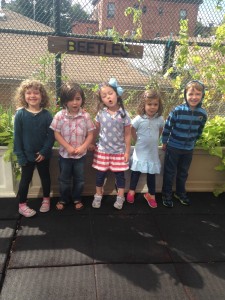 Beetle gardening class in front of their planter
Beetle gardening class in front of their planter
In gardening class we talked all about seeds and did some great work harvesting and collecting seeds! We started off looking at an ear of corn Red Seneca Corn that was actually grown in the garden at Irving . This organic corn seed was donated by a coop parent and originally purchased from Seed Savers. We talked about how normally the outside of the ear of corn is green, but with this particular variety the husk is dark red. Hence the name, Red Seneca! We also talked about how each kernel of corn could grow into a new corn plant! After investigating the ear of corn for a bit we moved on to some sunflower seed heads. These sunflower seed heads were also grown in the Irving garden and originally donated by a coop parent. We looked at the seed heads and started harvesting the seeds from the seed head. We noticed that there weren’t a lot of seeds and I told them that the birds had eaten most of the seeds, but that’s okay because birds get hungry too!
The Beetles did some great work harvesting the sunflower seeds and wanted to plant them immediately. We then talked about how it is best to plant seeds in the Spring. After collecting some seeds we brought them up to the classroom to add to the beetle science area.
Katydid:
Class 1: We observed a couple members of the squash family, a summer squash (ronde de nice), and two winter squash, a baby pumpkin and a fordhook acorn. When we sliced open the ronde de nice and pumpkin we discovered that those seeds were underdone and most likely sterile. Oh well. But we had success with the fordhook acorn! We washed the seeds in some water and placed them in a paper towel to dry off.
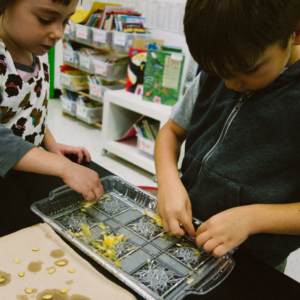
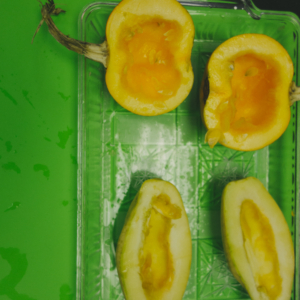
Class 2: We did some fantastic heirloom tomato seed saving and Red Seneca Corn observational drawings.
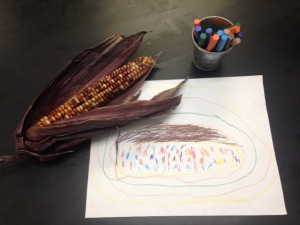
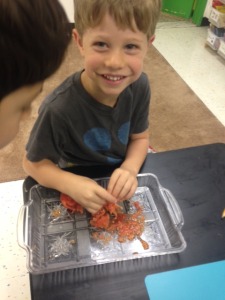
We then tasted a delicious heirloom tomato and some of us even had thirds and fourths!
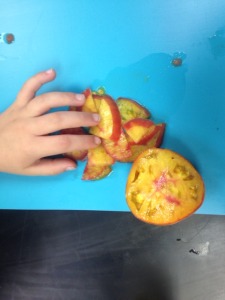
We then went up to the rooftop garden to work in our planter transplanting some carrots and refreshing the soil with compost.
Centipedes:
The First Graders observed Red Seneca Corn and harvested and ate cucumbers from the garden. We worked on our plant vocabulary (husk, silk, ear, cob, kernel, stalk) and discussed how each kernel could become a new plant.
Sharks:
The Second Graders had a great circle time conversation about seeds and looked at the Red Seneca Corn! We learned new gardening vocabulary and were kind of excited to learn that we eat different seeds all the time! We then went up to the roof to pick and eat the largest cucumber we could find in the garden. After snacking on some cucumbers we did some plant identification work and learned how to identify the different bean plants that are growing in the Brevoort garden, green bush beans, purple bush beans, and purple climbing beans!
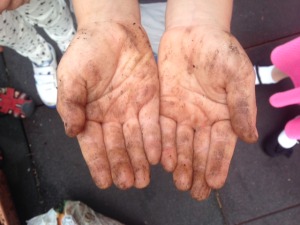
SPANISH WITH JEAN CARLA!
Katydids:
Our Kindergartners have been having a great time learning Spanish with “los grillitos.” So far, we have learned about identity, greetings, intro to months/seasons. We are currently learning about body parts, numbers (1-10), and colors. Literacy is very important so we have been reading books related to the themes we are working on. It is very significant for our class, if you practice with your child at home (always having fun) so that we can stay on the same page.
Centipedes
Our First Graders have been having a wonderful time in Spanish class with “los cienpiés.” We are currently practicing how to express our feelings through our morning greetings. Further more, we are applying our previous knowledge of numbers, colors, shapes, etc. to an exciting unit about the vowels and the alphabet. Please support our efforts by practicing with your child at home (always having fun). You can also attend cultural events and/or watch shows/videos in Spanish with your child.
Sharks
Our Second Graders have been having a great time in Spanish with “los tiburones.” We are currently practicing how to express our feelings during our morning greetings. Further more, we are applying our previous knowledge of numbers, colors, shapes, etc. to an exciting unit about the vowels and the alphabet. Literacy is very important so we have been busy at the library researching about vocabulary related to the vowels. Great job tiburones! Please support our efforts by practicing with your child at home (always having fun). You can also attend cultural events and/or watch shows/videos in Spanish with your child.
CAPOEIRA WITH PENA FOR PRE-K!
GYMNASTICS WITH JULIAN FOR K-2!

